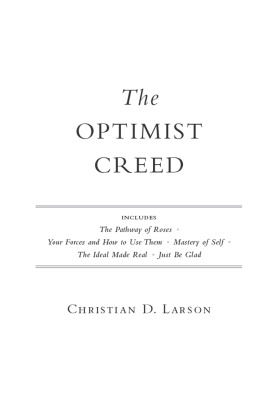Volume 105 of the Yale Series of Younger Poets
Radial Symmetry
Katherine Larson
FOREWORD BY LOUISE GLCK

Copyright2011 by Katherine Larson.
All rights reserved.
This book may not be reproduced, in whole or in part, including illustrations, in any form (beyond
that copying permitted by Sections 107 and 108 of the U.S. Copyright Law and except by reviewers
for the public press), without written permission from the publishers.
Yale University Press books may be purchased in quantity for educational, business, or promotional
use. For information, please e-mail sales.press@yale.edu (U.S. office) or
sales@yaleup.co.uk (U.K. office).
Designed by James J. Johnson and set in Garamond No. 3 type
by Keystone Typesetting, Inc., Orwigsburg, Pennsylvania.
Printed in the United States of America.
Library of Congress Cataloging-in-Publication Data
Larson, Katherine, 1977
Radial symmetry / Katherine Larson; foreword by Louise Glck.
p. cm. (Yale series of younger poets ; v. 105)
Includes bibliographical references.
ISBN 978-0-300-16919-5 (hardcover : alk. paper)
ISBN 978-0-300-16920-1 (pbk. : alk. paper)
I. Title.
PS3612.A7736R33 2011
811.6dc22
2010049524
A catalogue record for this book is available from the British Library.
This paper meets the requirements of ANSI/NISO Z39.48-1992 (Permanence of Paper).
10 9 8 7 6 5 4 3 2 1
for my mother and father
Cmo vive esa rosa que has prendido
junto a tu corazn?
Nunca hasta ahora contempl en la tierra
junto al volcn la flor.
How does that rose live, which you have captured
next to your heart?
Never until now did I contemplate on earth,
next to the volcano, the flower.
G. A. Bcquer, Rima XXII
CONTENTS
FOREWORD
The human fascination with beauty has produced many acts of tribute and imitation but relatively few insights, possibly because what transpires in the presence of beauty occurs in a mind initially mesmerized or stunned. Other sensations follow, none of them articulate: first a rush of excitement, this succeeded by a feeling of arrival, of completeness, and with this new completeness, insatiabilitythe enslaved attention refuses to relinquish its object. The hand (for example) cannot turn the page.
This power to stun the mind has diminished the prestige of beauty in literary discourse. It compels awe, and awe is well known for its capacity to silence. Here is nothing of the sort of puzzle or dilemma the mind prefers. Quite the opposite: beauty seems a sort of allpurpose solution to everything, obviating the debate and argument by which the mind is energized. In consequence, it disappears from debate: by both poets and critics, it is mentioned offhandedly or apologetically, as an incidental virtue or mild defect, unlikely to advance philosophical understanding. It existsserene, imperviousbeyond or apart from the vicissitudes of fashion; it cannot be achieved in the laboratories of ingenuity or craft. Miraculous, and also patently at odds with the play of intellect which (no matter how labored or how trivial) monopolizes contemporary attention and stimulates elaborate response. Numinous and clear, the beautiful offends the mind with its quality of selfsufficiency or finality.
Nowhere is this schism between public approbation and secret power more intensely played out than in lyric poetry. This is one of Keatss great themes: to suggest that beauty subverts the mind is not to suggest that its appeal is fundamentally or exclusively to the senses. It speaks to some abiding longing: for the pure, for the apparently whole. Song directed not to the sensual earin its presence, the suspicious reader is both helpless and exalted (not, I would say, cerebral responses). In such moments, the poem seems not a relic but an absolute. Time, narrative time, is abolished. The only close parallel is falling in love:
The late cranes throwing
their necks to the wind stay
somewhere between
the place that rain begins
and the place that it ends
they seem to exist just there
above the horizon at least
I only see them that way
tossed up
against the gray October
light not heavy enough
for feet to be useful or
useless enough to make
gravity untie its string. Im sick
of this stubbornness
but the earthworms
seem to think it all right
they move forward
and let the world pass
through them they eat
and eat at it, content to connect
everything through
the individual links
of their purple bodies to stay
one place would be death.
But somewhere between
the crane and the worm
between the days I pass through
and the days that pass
through me
in the mind. And memory
which outruns the body and
grief which arrests it.
Statuary
How vulnerable it seems, this poem, how fragile: a narrow column of awareness, its movement too perpetual or too transfixed to seem headlong, despite its unpunctuated urgencies. The elemental grandeur of the oppositionsbirth and death, heaven and earth, crane and wormand of the mimetic structure, the explicit lesson that to stay / one place would be death: these could veer close to parody or sentimentality were it not for Katherine Larsons grace and simplicity, her eerie purity of tone. Statuary (like most of the poems in Radial Symmetry) moves toward synthesis and repose (rather than toward ecstatic disintegration), toward containment as opposed to release. But containment and repose do not imply, here, a placid summary or moral. Larsons repose is also a quivering suspension, in which multiple perceptions, multiple elements, are held in extended and mysterious relation. The shape is classic; in Statuary Larson has not so much made something new as she has given form to ancient knowledge.
This is a poem of great beauty. But beauty is also Larsons subject. So much of earth is here, at once utterly natural and wholly illumined: a grave passivity infuses this collection; experience is less sought than received. The poet is a kind of dazed Miranda, so new to the world that its every ordinariness seems an emblem of wonder. Either everythings sublime or nothing is, she writes, and for the span of the book, everything is.
Larson trained as a biologist, but these poems do not seem (at least to a layman) a scientists work. They prize sensation over analytic scrutiny, the individual example over the category. Her education in science manifests here as a passion for detail (as well as a richness of reference): I know Im still alive because I love / to eat, she says, and everywhere in this work is the sensualists grateful and specific avidity. The longest poem in the book, Ghost Nets, makes a kind of dreamlike diary of being; the precision and variety of Larsons impressions, their layered abundance, correspond to the gleanings of some very lucky (and actual) nets. The implications of the title also make of the poem a protest: an informed defense of unprotected life in the face of casually pervasive human destructiveness. Each section seems a gift, an instance of harmoniousness between consciousness and flesh, the scientists fastidious attention to detail suffused with an unexpected gentleness or solicitude toward matter:
Yellow snapper, bright as egg yolk. I look at the sea and eat my toast.
Yesterdays lessonthe jabonero de Corts or Cortez soapfish
when agitated
secretes a mucus that lathers like soap
Ghost Nets / I
Next page












